Management Accounting Report: Roles, Systems, and Budgets
VerifiedAdded on 2020/10/05
|13
|2987
|90
Report
AI Summary
This report provides a comprehensive overview of management accounting, exploring its critical role in business decision-making and strategic planning. It differentiates management accounting from financial accounting, highlighting their distinct objectives, applications, and reporting structures. The report delves into various management accounting systems, including balance scorecards and budgeting, detailing their advantages and disadvantages. It includes practical applications such as break-even analysis under different scenarios, calculating contribution per unit, and determining the impact of price changes on sales and profits. Furthermore, the report examines different types of budgets – static, zero-based, rolling, and incremental – discussing their merits and demerits, and emphasizing the importance of preparing budgets for financial control and goal achievement. The report also covers inventory valuation methods.
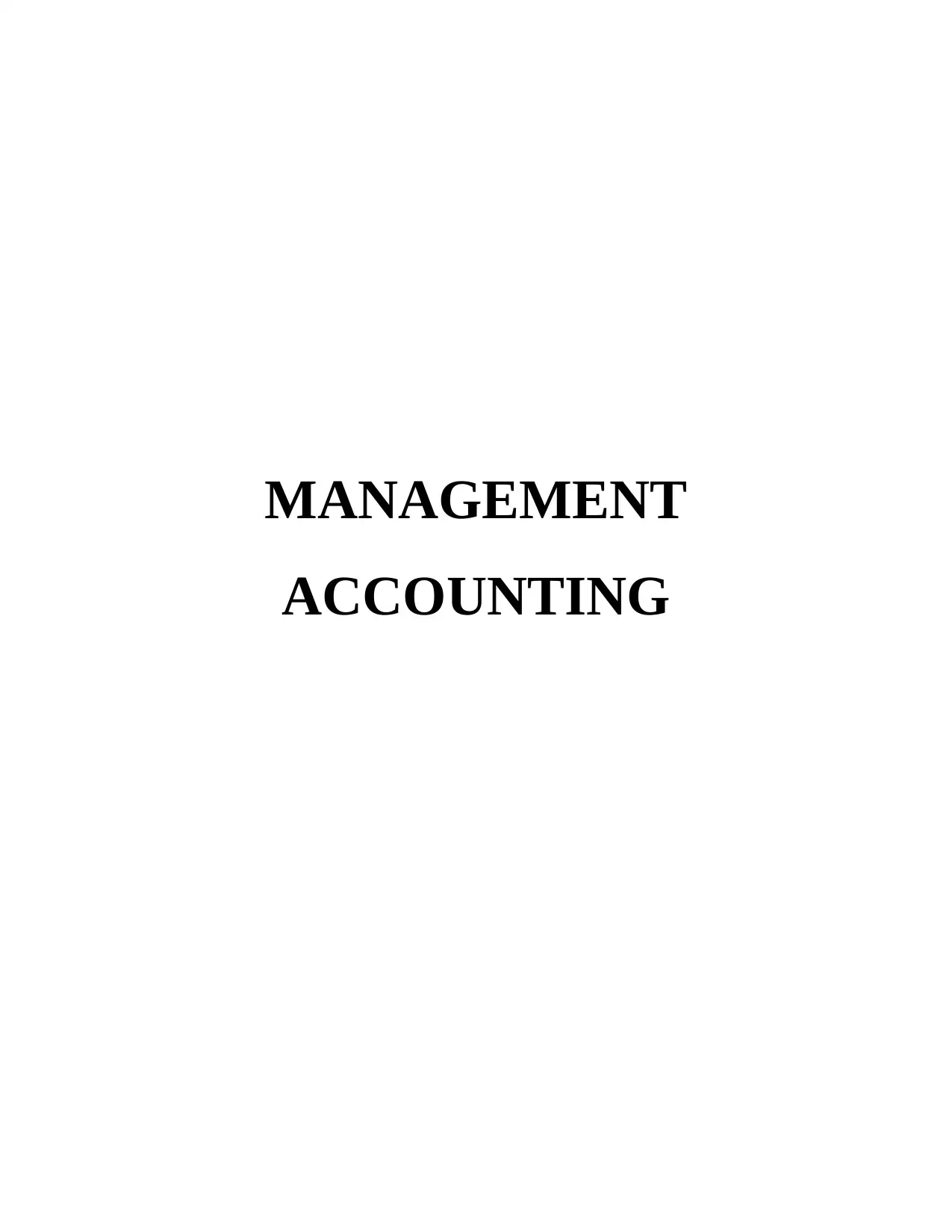
MANAGEMENT
ACCOUNTING
ACCOUNTING
Paraphrase This Document
Need a fresh take? Get an instant paraphrase of this document with our AI Paraphraser
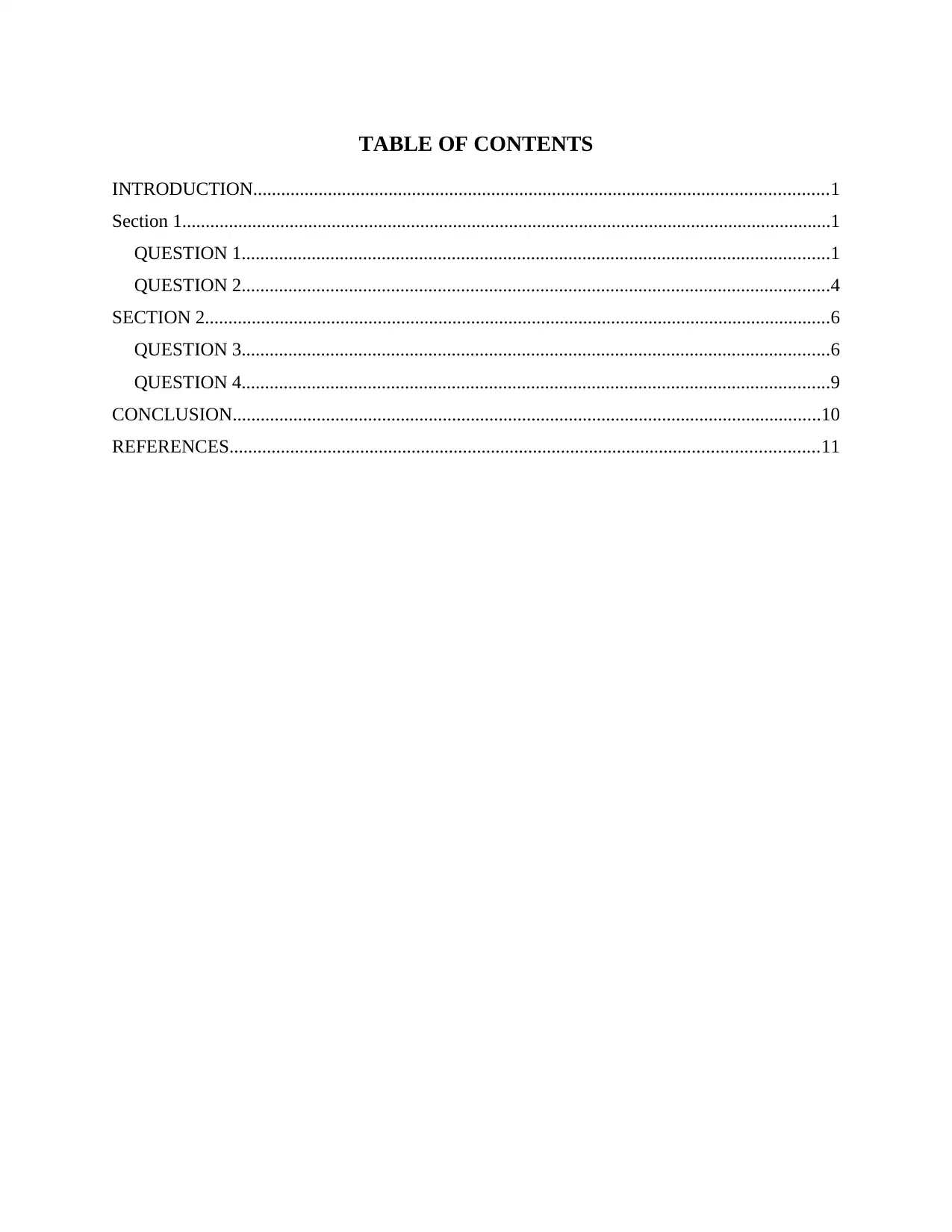
TABLE OF CONTENTS
INTRODUCTION...........................................................................................................................1
Section 1...........................................................................................................................................1
QUESTION 1..............................................................................................................................1
QUESTION 2..............................................................................................................................4
SECTION 2......................................................................................................................................6
QUESTION 3..............................................................................................................................6
QUESTION 4..............................................................................................................................9
CONCLUSION..............................................................................................................................10
REFERENCES..............................................................................................................................11
INTRODUCTION...........................................................................................................................1
Section 1...........................................................................................................................................1
QUESTION 1..............................................................................................................................1
QUESTION 2..............................................................................................................................4
SECTION 2......................................................................................................................................6
QUESTION 3..............................................................................................................................6
QUESTION 4..............................................................................................................................9
CONCLUSION..............................................................................................................................10
REFERENCES..............................................................................................................................11
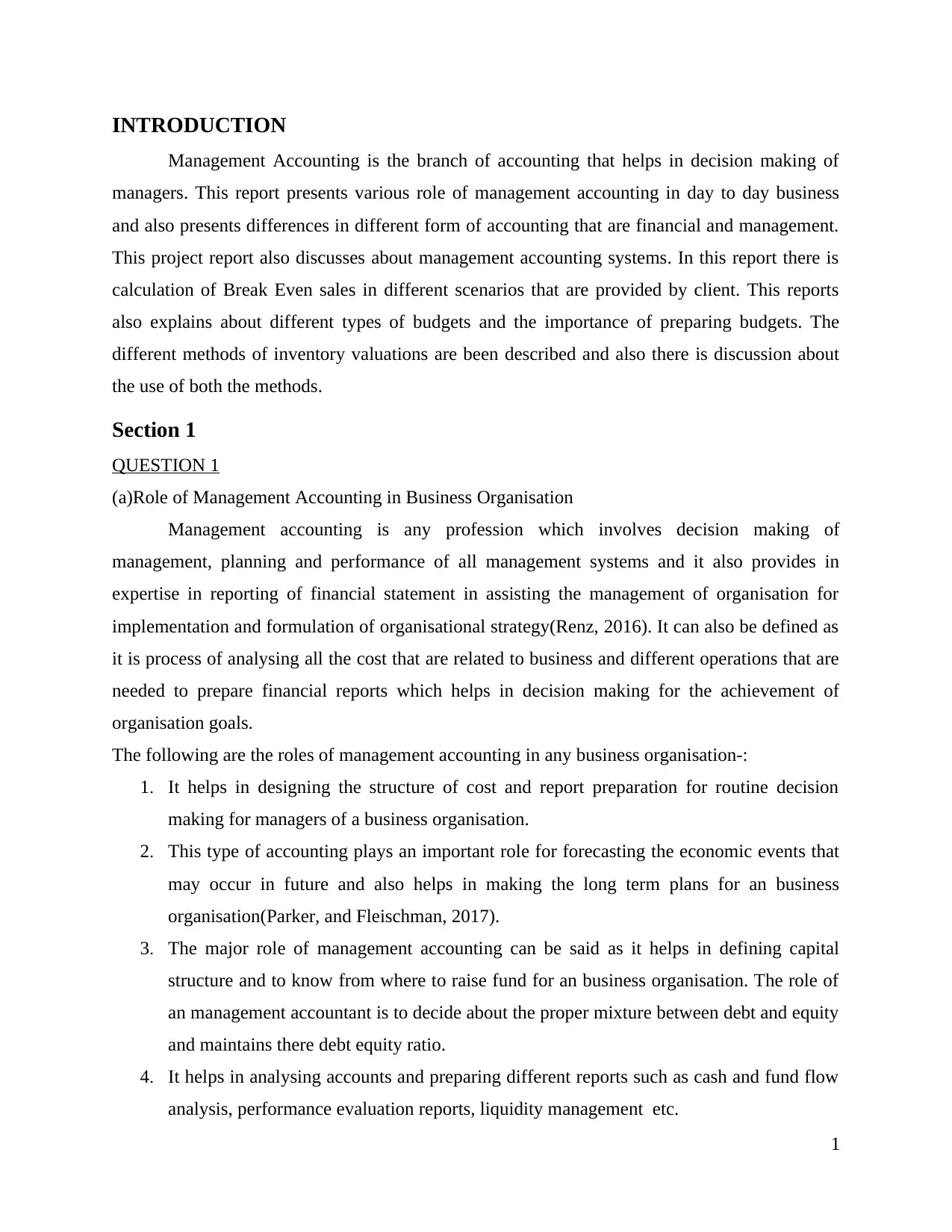
INTRODUCTION
Management Accounting is the branch of accounting that helps in decision making of
managers. This report presents various role of management accounting in day to day business
and also presents differences in different form of accounting that are financial and management.
This project report also discusses about management accounting systems. In this report there is
calculation of Break Even sales in different scenarios that are provided by client. This reports
also explains about different types of budgets and the importance of preparing budgets. The
different methods of inventory valuations are been described and also there is discussion about
the use of both the methods.
Section 1
QUESTION 1
(a)Role of Management Accounting in Business Organisation
Management accounting is any profession which involves decision making of
management, planning and performance of all management systems and it also provides in
expertise in reporting of financial statement in assisting the management of organisation for
implementation and formulation of organisational strategy(Renz, 2016). It can also be defined as
it is process of analysing all the cost that are related to business and different operations that are
needed to prepare financial reports which helps in decision making for the achievement of
organisation goals.
The following are the roles of management accounting in any business organisation-:
1. It helps in designing the structure of cost and report preparation for routine decision
making for managers of a business organisation.
2. This type of accounting plays an important role for forecasting the economic events that
may occur in future and also helps in making the long term plans for an business
organisation(Parker, and Fleischman, 2017).
3. The major role of management accounting can be said as it helps in defining capital
structure and to know from where to raise fund for an business organisation. The role of
an management accountant is to decide about the proper mixture between debt and equity
and maintains there debt equity ratio.
4. It helps in analysing accounts and preparing different reports such as cash and fund flow
analysis, performance evaluation reports, liquidity management etc.
1
Management Accounting is the branch of accounting that helps in decision making of
managers. This report presents various role of management accounting in day to day business
and also presents differences in different form of accounting that are financial and management.
This project report also discusses about management accounting systems. In this report there is
calculation of Break Even sales in different scenarios that are provided by client. This reports
also explains about different types of budgets and the importance of preparing budgets. The
different methods of inventory valuations are been described and also there is discussion about
the use of both the methods.
Section 1
QUESTION 1
(a)Role of Management Accounting in Business Organisation
Management accounting is any profession which involves decision making of
management, planning and performance of all management systems and it also provides in
expertise in reporting of financial statement in assisting the management of organisation for
implementation and formulation of organisational strategy(Renz, 2016). It can also be defined as
it is process of analysing all the cost that are related to business and different operations that are
needed to prepare financial reports which helps in decision making for the achievement of
organisation goals.
The following are the roles of management accounting in any business organisation-:
1. It helps in designing the structure of cost and report preparation for routine decision
making for managers of a business organisation.
2. This type of accounting plays an important role for forecasting the economic events that
may occur in future and also helps in making the long term plans for an business
organisation(Parker, and Fleischman, 2017).
3. The major role of management accounting can be said as it helps in defining capital
structure and to know from where to raise fund for an business organisation. The role of
an management accountant is to decide about the proper mixture between debt and equity
and maintains there debt equity ratio.
4. It helps in analysing accounts and preparing different reports such as cash and fund flow
analysis, performance evaluation reports, liquidity management etc.
1
⊘ This is a preview!⊘
Do you want full access?
Subscribe today to unlock all pages.

Trusted by 1+ million students worldwide
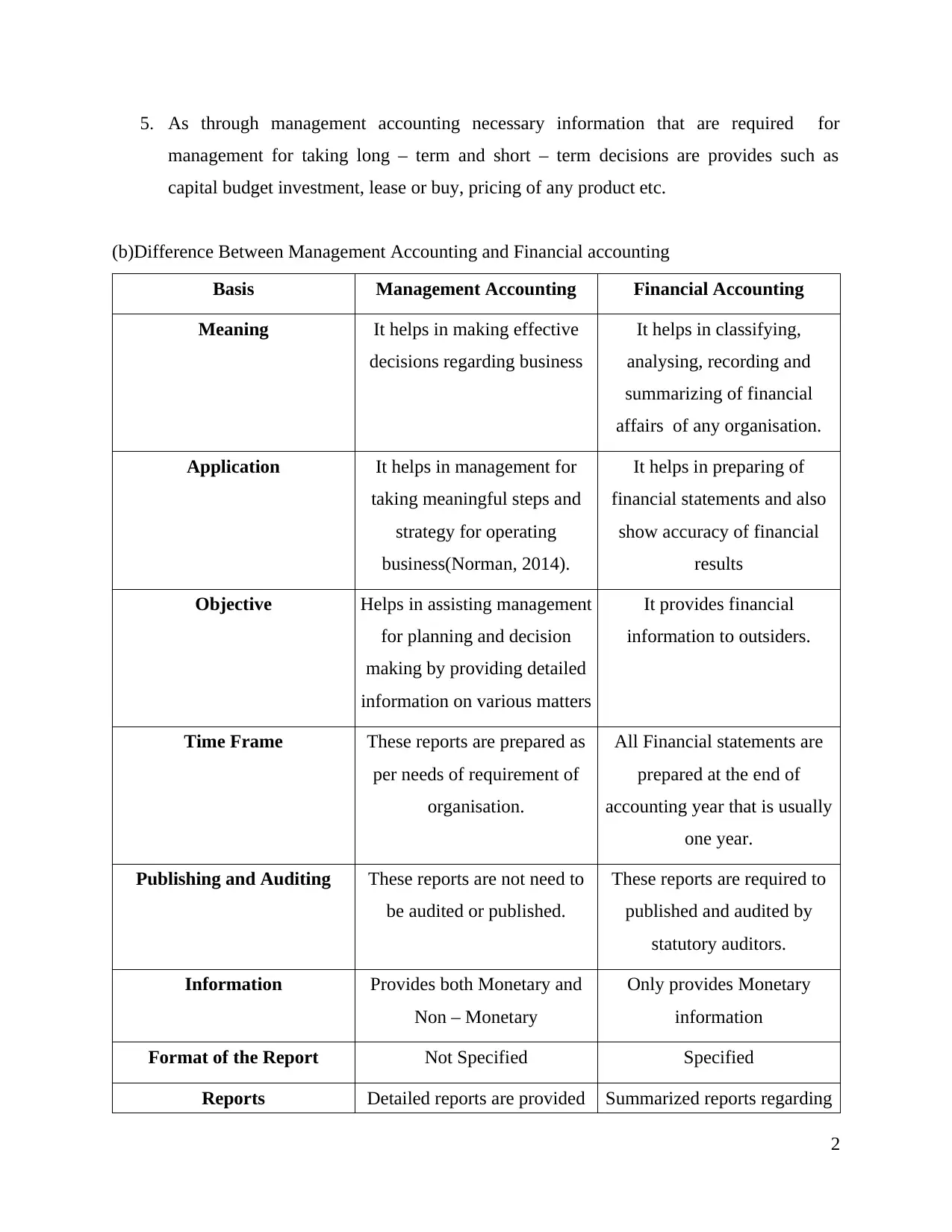
5. As through management accounting necessary information that are required for
management for taking long – term and short – term decisions are provides such as
capital budget investment, lease or buy, pricing of any product etc.
(b)Difference Between Management Accounting and Financial accounting
Basis Management Accounting Financial Accounting
Meaning It helps in making effective
decisions regarding business
It helps in classifying,
analysing, recording and
summarizing of financial
affairs of any organisation.
Application It helps in management for
taking meaningful steps and
strategy for operating
business(Norman, 2014).
It helps in preparing of
financial statements and also
show accuracy of financial
results
Objective Helps in assisting management
for planning and decision
making by providing detailed
information on various matters
It provides financial
information to outsiders.
Time Frame These reports are prepared as
per needs of requirement of
organisation.
All Financial statements are
prepared at the end of
accounting year that is usually
one year.
Publishing and Auditing These reports are not need to
be audited or published.
These reports are required to
published and audited by
statutory auditors.
Information Provides both Monetary and
Non – Monetary
Only provides Monetary
information
Format of the Report Not Specified Specified
Reports Detailed reports are provided Summarized reports regarding
2
management for taking long – term and short – term decisions are provides such as
capital budget investment, lease or buy, pricing of any product etc.
(b)Difference Between Management Accounting and Financial accounting
Basis Management Accounting Financial Accounting
Meaning It helps in making effective
decisions regarding business
It helps in classifying,
analysing, recording and
summarizing of financial
affairs of any organisation.
Application It helps in management for
taking meaningful steps and
strategy for operating
business(Norman, 2014).
It helps in preparing of
financial statements and also
show accuracy of financial
results
Objective Helps in assisting management
for planning and decision
making by providing detailed
information on various matters
It provides financial
information to outsiders.
Time Frame These reports are prepared as
per needs of requirement of
organisation.
All Financial statements are
prepared at the end of
accounting year that is usually
one year.
Publishing and Auditing These reports are not need to
be audited or published.
These reports are required to
published and audited by
statutory auditors.
Information Provides both Monetary and
Non – Monetary
Only provides Monetary
information
Format of the Report Not Specified Specified
Reports Detailed reports are provided Summarized reports regarding
2
Paraphrase This Document
Need a fresh take? Get an instant paraphrase of this document with our AI Paraphraser
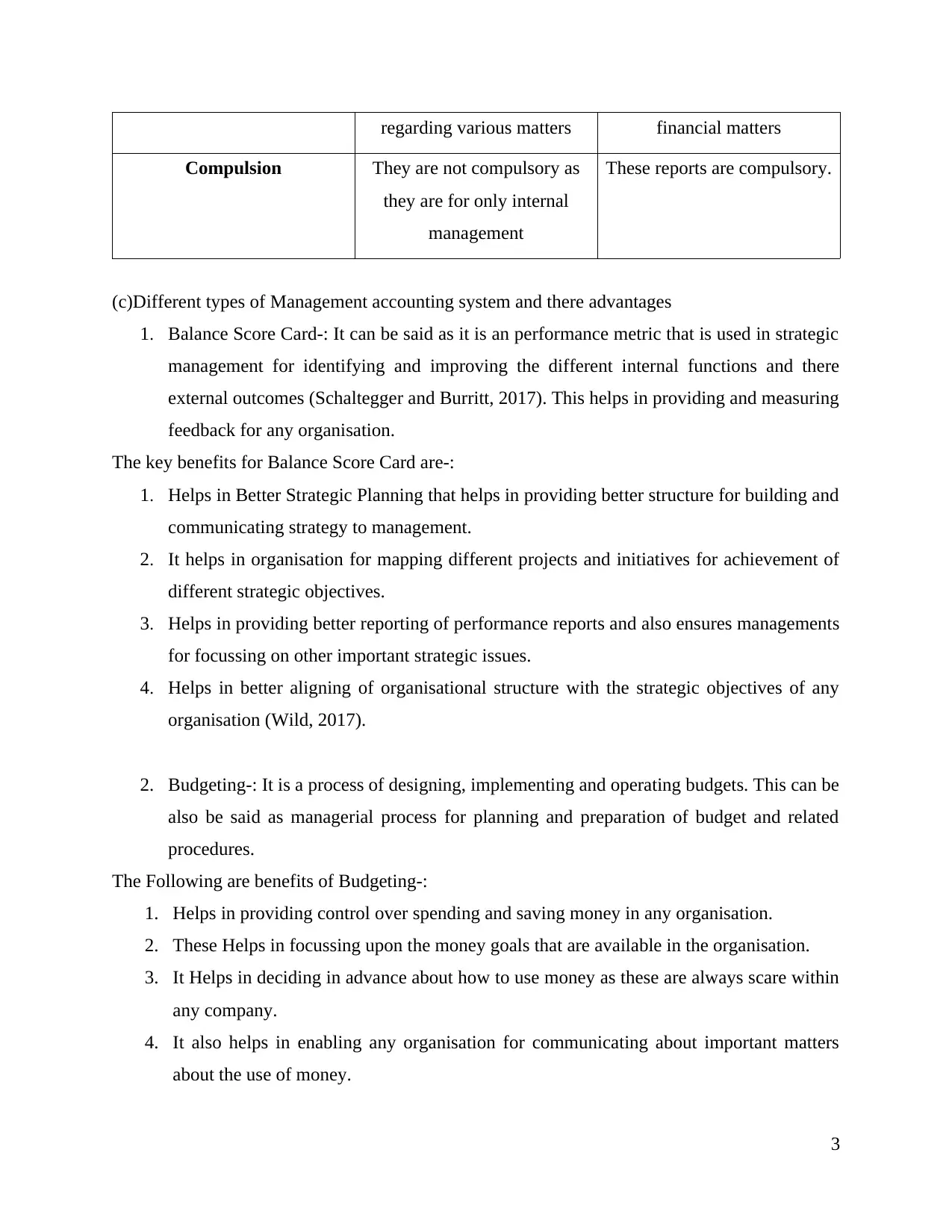
regarding various matters financial matters
Compulsion They are not compulsory as
they are for only internal
management
These reports are compulsory.
(c)Different types of Management accounting system and there advantages
1. Balance Score Card-: It can be said as it is an performance metric that is used in strategic
management for identifying and improving the different internal functions and there
external outcomes (Schaltegger and Burritt, 2017). This helps in providing and measuring
feedback for any organisation.
The key benefits for Balance Score Card are-:
1. Helps in Better Strategic Planning that helps in providing better structure for building and
communicating strategy to management.
2. It helps in organisation for mapping different projects and initiatives for achievement of
different strategic objectives.
3. Helps in providing better reporting of performance reports and also ensures managements
for focussing on other important strategic issues.
4. Helps in better aligning of organisational structure with the strategic objectives of any
organisation (Wild, 2017).
2. Budgeting-: It is a process of designing, implementing and operating budgets. This can be
also be said as managerial process for planning and preparation of budget and related
procedures.
The Following are benefits of Budgeting-:
1. Helps in providing control over spending and saving money in any organisation.
2. These Helps in focussing upon the money goals that are available in the organisation.
3. It Helps in deciding in advance about how to use money as these are always scare within
any company.
4. It also helps in enabling any organisation for communicating about important matters
about the use of money.
3
Compulsion They are not compulsory as
they are for only internal
management
These reports are compulsory.
(c)Different types of Management accounting system and there advantages
1. Balance Score Card-: It can be said as it is an performance metric that is used in strategic
management for identifying and improving the different internal functions and there
external outcomes (Schaltegger and Burritt, 2017). This helps in providing and measuring
feedback for any organisation.
The key benefits for Balance Score Card are-:
1. Helps in Better Strategic Planning that helps in providing better structure for building and
communicating strategy to management.
2. It helps in organisation for mapping different projects and initiatives for achievement of
different strategic objectives.
3. Helps in providing better reporting of performance reports and also ensures managements
for focussing on other important strategic issues.
4. Helps in better aligning of organisational structure with the strategic objectives of any
organisation (Wild, 2017).
2. Budgeting-: It is a process of designing, implementing and operating budgets. This can be
also be said as managerial process for planning and preparation of budget and related
procedures.
The Following are benefits of Budgeting-:
1. Helps in providing control over spending and saving money in any organisation.
2. These Helps in focussing upon the money goals that are available in the organisation.
3. It Helps in deciding in advance about how to use money as these are always scare within
any company.
4. It also helps in enabling any organisation for communicating about important matters
about the use of money.
3
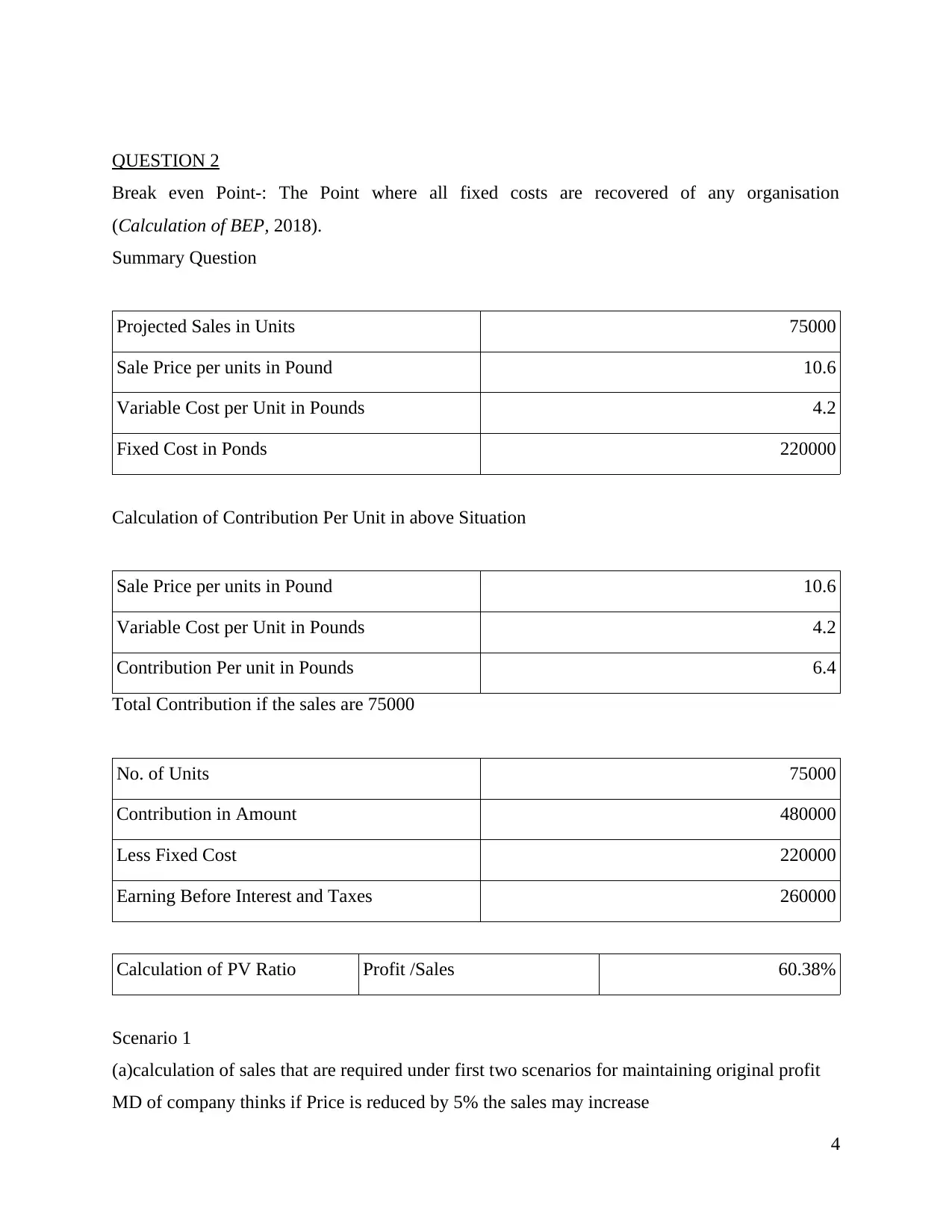
QUESTION 2
Break even Point-: The Point where all fixed costs are recovered of any organisation
(Calculation of BEP, 2018).
Summary Question
Projected Sales in Units 75000
Sale Price per units in Pound 10.6
Variable Cost per Unit in Pounds 4.2
Fixed Cost in Ponds 220000
Calculation of Contribution Per Unit in above Situation
Sale Price per units in Pound 10.6
Variable Cost per Unit in Pounds 4.2
Contribution Per unit in Pounds 6.4
Total Contribution if the sales are 75000
No. of Units 75000
Contribution in Amount 480000
Less Fixed Cost 220000
Earning Before Interest and Taxes 260000
Calculation of PV Ratio Profit /Sales 60.38%
Scenario 1
(a)calculation of sales that are required under first two scenarios for maintaining original profit
MD of company thinks if Price is reduced by 5% the sales may increase
4
Break even Point-: The Point where all fixed costs are recovered of any organisation
(Calculation of BEP, 2018).
Summary Question
Projected Sales in Units 75000
Sale Price per units in Pound 10.6
Variable Cost per Unit in Pounds 4.2
Fixed Cost in Ponds 220000
Calculation of Contribution Per Unit in above Situation
Sale Price per units in Pound 10.6
Variable Cost per Unit in Pounds 4.2
Contribution Per unit in Pounds 6.4
Total Contribution if the sales are 75000
No. of Units 75000
Contribution in Amount 480000
Less Fixed Cost 220000
Earning Before Interest and Taxes 260000
Calculation of PV Ratio Profit /Sales 60.38%
Scenario 1
(a)calculation of sales that are required under first two scenarios for maintaining original profit
MD of company thinks if Price is reduced by 5% the sales may increase
4
⊘ This is a preview!⊘
Do you want full access?
Subscribe today to unlock all pages.

Trusted by 1+ million students worldwide
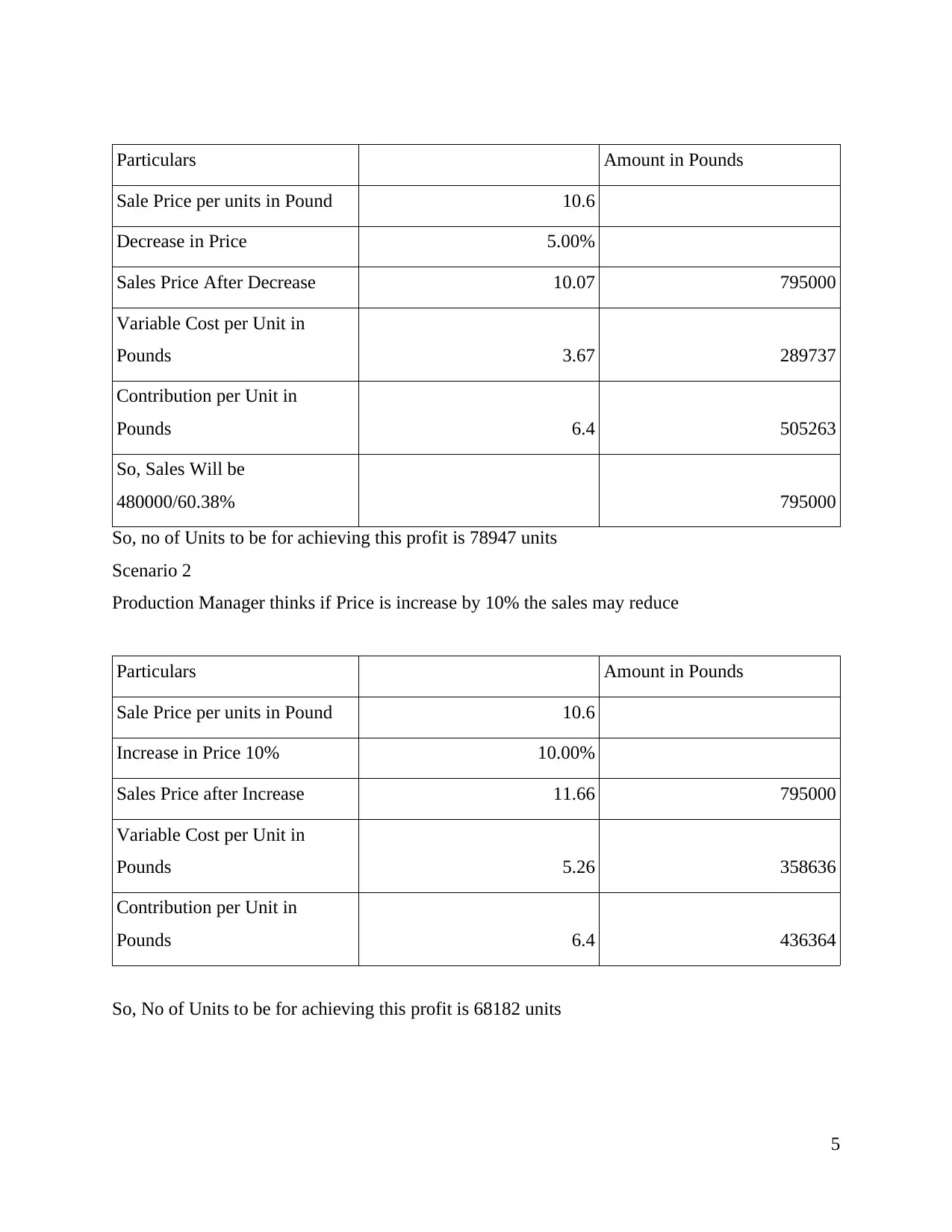
Particulars Amount in Pounds
Sale Price per units in Pound 10.6
Decrease in Price 5.00%
Sales Price After Decrease 10.07 795000
Variable Cost per Unit in
Pounds 3.67 289737
Contribution per Unit in
Pounds 6.4 505263
So, Sales Will be
480000/60.38% 795000
So, no of Units to be for achieving this profit is 78947 units
Scenario 2
Production Manager thinks if Price is increase by 10% the sales may reduce
Particulars Amount in Pounds
Sale Price per units in Pound 10.6
Increase in Price 10% 10.00%
Sales Price after Increase 11.66 795000
Variable Cost per Unit in
Pounds 5.26 358636
Contribution per Unit in
Pounds 6.4 436364
So, No of Units to be for achieving this profit is 68182 units
5
Sale Price per units in Pound 10.6
Decrease in Price 5.00%
Sales Price After Decrease 10.07 795000
Variable Cost per Unit in
Pounds 3.67 289737
Contribution per Unit in
Pounds 6.4 505263
So, Sales Will be
480000/60.38% 795000
So, no of Units to be for achieving this profit is 78947 units
Scenario 2
Production Manager thinks if Price is increase by 10% the sales may reduce
Particulars Amount in Pounds
Sale Price per units in Pound 10.6
Increase in Price 10% 10.00%
Sales Price after Increase 11.66 795000
Variable Cost per Unit in
Pounds 5.26 358636
Contribution per Unit in
Pounds 6.4 436364
So, No of Units to be for achieving this profit is 68182 units
5
Paraphrase This Document
Need a fresh take? Get an instant paraphrase of this document with our AI Paraphraser
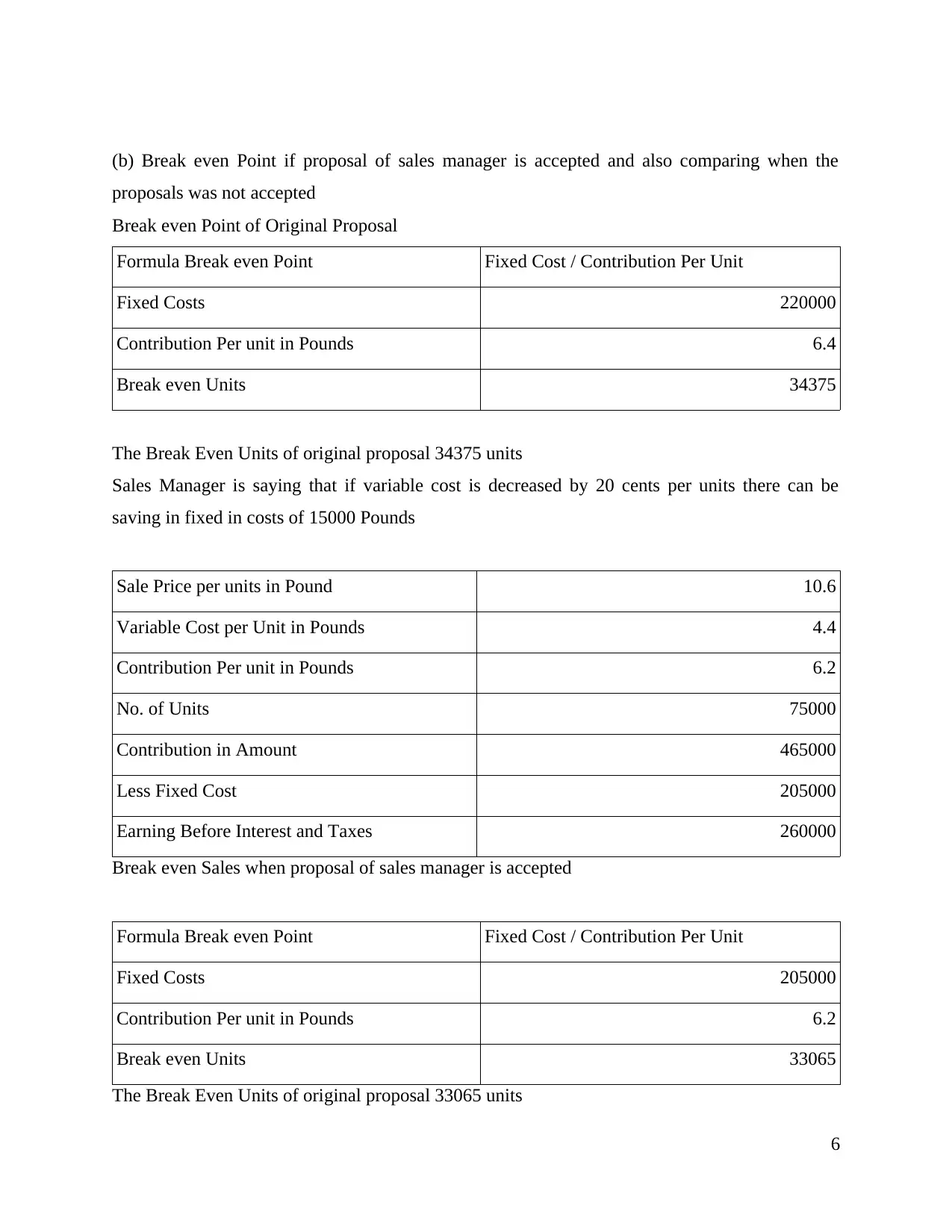
(b) Break even Point if proposal of sales manager is accepted and also comparing when the
proposals was not accepted
Break even Point of Original Proposal
Formula Break even Point Fixed Cost / Contribution Per Unit
Fixed Costs 220000
Contribution Per unit in Pounds 6.4
Break even Units 34375
The Break Even Units of original proposal 34375 units
Sales Manager is saying that if variable cost is decreased by 20 cents per units there can be
saving in fixed in costs of 15000 Pounds
Sale Price per units in Pound 10.6
Variable Cost per Unit in Pounds 4.4
Contribution Per unit in Pounds 6.2
No. of Units 75000
Contribution in Amount 465000
Less Fixed Cost 205000
Earning Before Interest and Taxes 260000
Break even Sales when proposal of sales manager is accepted
Formula Break even Point Fixed Cost / Contribution Per Unit
Fixed Costs 205000
Contribution Per unit in Pounds 6.2
Break even Units 33065
The Break Even Units of original proposal 33065 units
6
proposals was not accepted
Break even Point of Original Proposal
Formula Break even Point Fixed Cost / Contribution Per Unit
Fixed Costs 220000
Contribution Per unit in Pounds 6.4
Break even Units 34375
The Break Even Units of original proposal 34375 units
Sales Manager is saying that if variable cost is decreased by 20 cents per units there can be
saving in fixed in costs of 15000 Pounds
Sale Price per units in Pound 10.6
Variable Cost per Unit in Pounds 4.4
Contribution Per unit in Pounds 6.2
No. of Units 75000
Contribution in Amount 465000
Less Fixed Cost 205000
Earning Before Interest and Taxes 260000
Break even Sales when proposal of sales manager is accepted
Formula Break even Point Fixed Cost / Contribution Per Unit
Fixed Costs 205000
Contribution Per unit in Pounds 6.2
Break even Units 33065
The Break Even Units of original proposal 33065 units
6
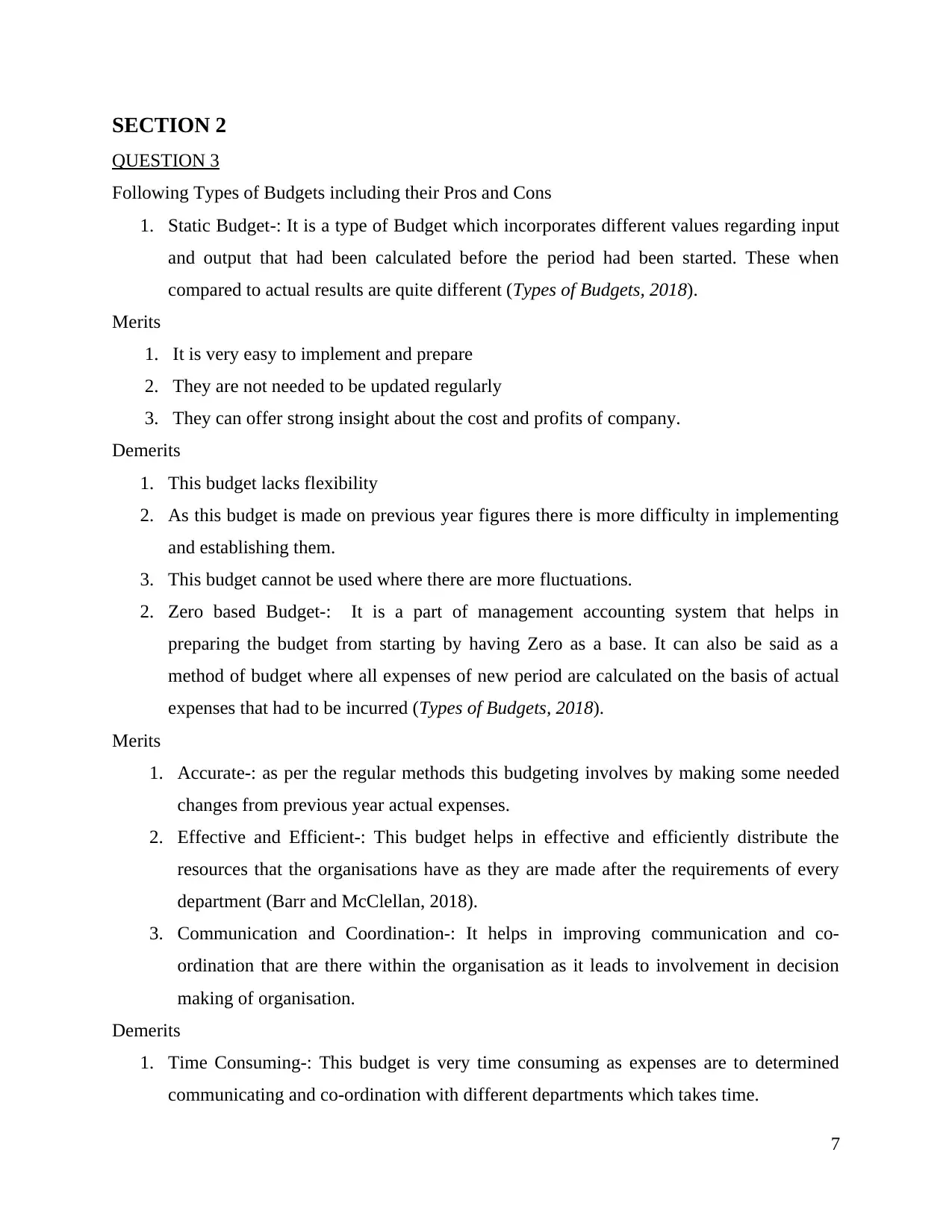
SECTION 2
QUESTION 3
Following Types of Budgets including their Pros and Cons
1. Static Budget-: It is a type of Budget which incorporates different values regarding input
and output that had been calculated before the period had been started. These when
compared to actual results are quite different (Types of Budgets, 2018).
Merits
1. It is very easy to implement and prepare
2. They are not needed to be updated regularly
3. They can offer strong insight about the cost and profits of company.
Demerits
1. This budget lacks flexibility
2. As this budget is made on previous year figures there is more difficulty in implementing
and establishing them.
3. This budget cannot be used where there are more fluctuations.
2. Zero based Budget-: It is a part of management accounting system that helps in
preparing the budget from starting by having Zero as a base. It can also be said as a
method of budget where all expenses of new period are calculated on the basis of actual
expenses that had to be incurred (Types of Budgets, 2018).
Merits
1. Accurate-: as per the regular methods this budgeting involves by making some needed
changes from previous year actual expenses.
2. Effective and Efficient-: This budget helps in effective and efficiently distribute the
resources that the organisations have as they are made after the requirements of every
department (Barr and McClellan, 2018).
3. Communication and Coordination-: It helps in improving communication and co-
ordination that are there within the organisation as it leads to involvement in decision
making of organisation.
Demerits
1. Time Consuming-: This budget is very time consuming as expenses are to determined
communicating and co-ordination with different departments which takes time.
7
QUESTION 3
Following Types of Budgets including their Pros and Cons
1. Static Budget-: It is a type of Budget which incorporates different values regarding input
and output that had been calculated before the period had been started. These when
compared to actual results are quite different (Types of Budgets, 2018).
Merits
1. It is very easy to implement and prepare
2. They are not needed to be updated regularly
3. They can offer strong insight about the cost and profits of company.
Demerits
1. This budget lacks flexibility
2. As this budget is made on previous year figures there is more difficulty in implementing
and establishing them.
3. This budget cannot be used where there are more fluctuations.
2. Zero based Budget-: It is a part of management accounting system that helps in
preparing the budget from starting by having Zero as a base. It can also be said as a
method of budget where all expenses of new period are calculated on the basis of actual
expenses that had to be incurred (Types of Budgets, 2018).
Merits
1. Accurate-: as per the regular methods this budgeting involves by making some needed
changes from previous year actual expenses.
2. Effective and Efficient-: This budget helps in effective and efficiently distribute the
resources that the organisations have as they are made after the requirements of every
department (Barr and McClellan, 2018).
3. Communication and Coordination-: It helps in improving communication and co-
ordination that are there within the organisation as it leads to involvement in decision
making of organisation.
Demerits
1. Time Consuming-: This budget is very time consuming as expenses are to determined
communicating and co-ordination with different departments which takes time.
7
⊘ This is a preview!⊘
Do you want full access?
Subscribe today to unlock all pages.

Trusted by 1+ million students worldwide
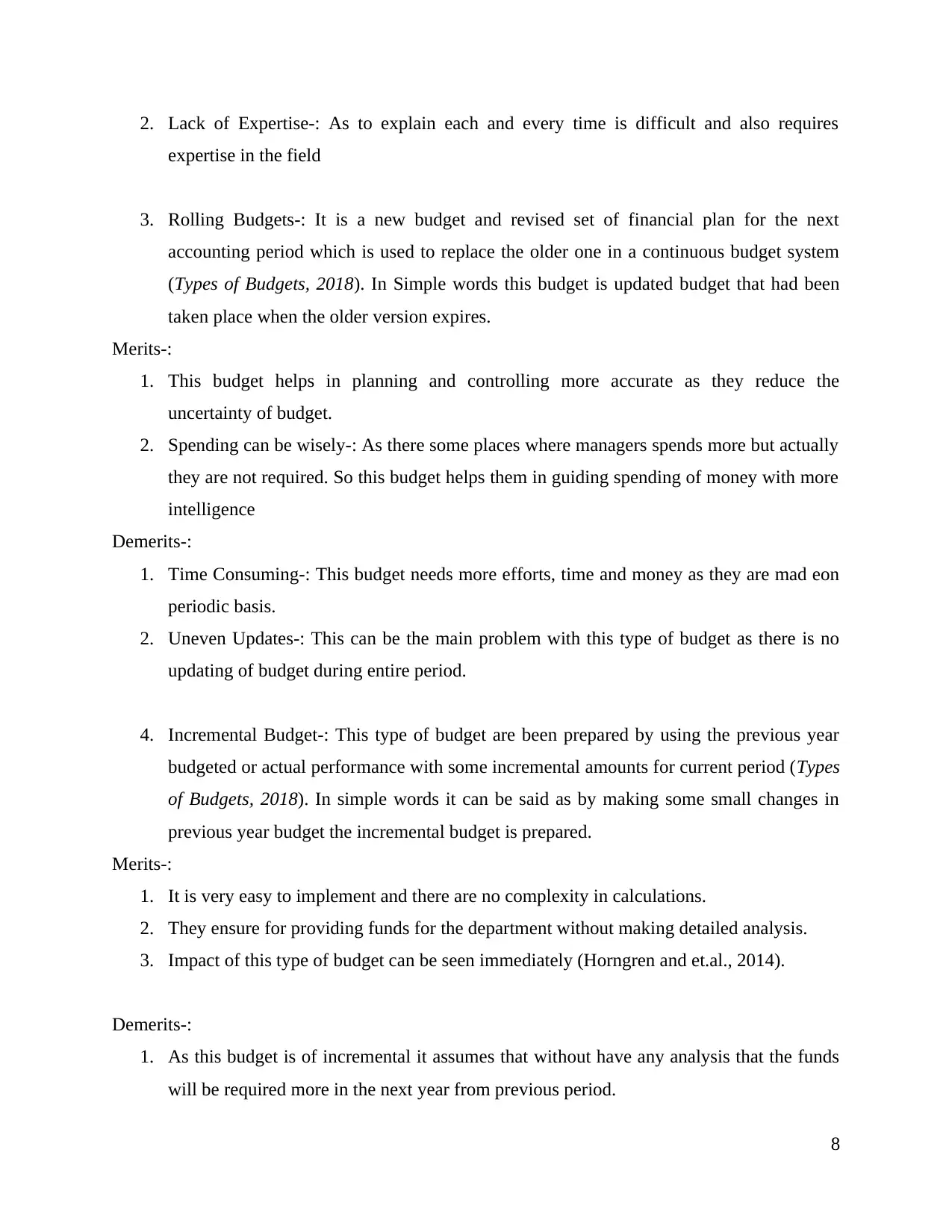
2. Lack of Expertise-: As to explain each and every time is difficult and also requires
expertise in the field
3. Rolling Budgets-: It is a new budget and revised set of financial plan for the next
accounting period which is used to replace the older one in a continuous budget system
(Types of Budgets, 2018). In Simple words this budget is updated budget that had been
taken place when the older version expires.
Merits-:
1. This budget helps in planning and controlling more accurate as they reduce the
uncertainty of budget.
2. Spending can be wisely-: As there some places where managers spends more but actually
they are not required. So this budget helps them in guiding spending of money with more
intelligence
Demerits-:
1. Time Consuming-: This budget needs more efforts, time and money as they are mad eon
periodic basis.
2. Uneven Updates-: This can be the main problem with this type of budget as there is no
updating of budget during entire period.
4. Incremental Budget-: This type of budget are been prepared by using the previous year
budgeted or actual performance with some incremental amounts for current period (Types
of Budgets, 2018). In simple words it can be said as by making some small changes in
previous year budget the incremental budget is prepared.
Merits-:
1. It is very easy to implement and there are no complexity in calculations.
2. They ensure for providing funds for the department without making detailed analysis.
3. Impact of this type of budget can be seen immediately (Horngren and et.al., 2014).
Demerits-:
1. As this budget is of incremental it assumes that without have any analysis that the funds
will be required more in the next year from previous period.
8
expertise in the field
3. Rolling Budgets-: It is a new budget and revised set of financial plan for the next
accounting period which is used to replace the older one in a continuous budget system
(Types of Budgets, 2018). In Simple words this budget is updated budget that had been
taken place when the older version expires.
Merits-:
1. This budget helps in planning and controlling more accurate as they reduce the
uncertainty of budget.
2. Spending can be wisely-: As there some places where managers spends more but actually
they are not required. So this budget helps them in guiding spending of money with more
intelligence
Demerits-:
1. Time Consuming-: This budget needs more efforts, time and money as they are mad eon
periodic basis.
2. Uneven Updates-: This can be the main problem with this type of budget as there is no
updating of budget during entire period.
4. Incremental Budget-: This type of budget are been prepared by using the previous year
budgeted or actual performance with some incremental amounts for current period (Types
of Budgets, 2018). In simple words it can be said as by making some small changes in
previous year budget the incremental budget is prepared.
Merits-:
1. It is very easy to implement and there are no complexity in calculations.
2. They ensure for providing funds for the department without making detailed analysis.
3. Impact of this type of budget can be seen immediately (Horngren and et.al., 2014).
Demerits-:
1. As this budget is of incremental it assumes that without have any analysis that the funds
will be required more in the next year from previous period.
8
Paraphrase This Document
Need a fresh take? Get an instant paraphrase of this document with our AI Paraphraser
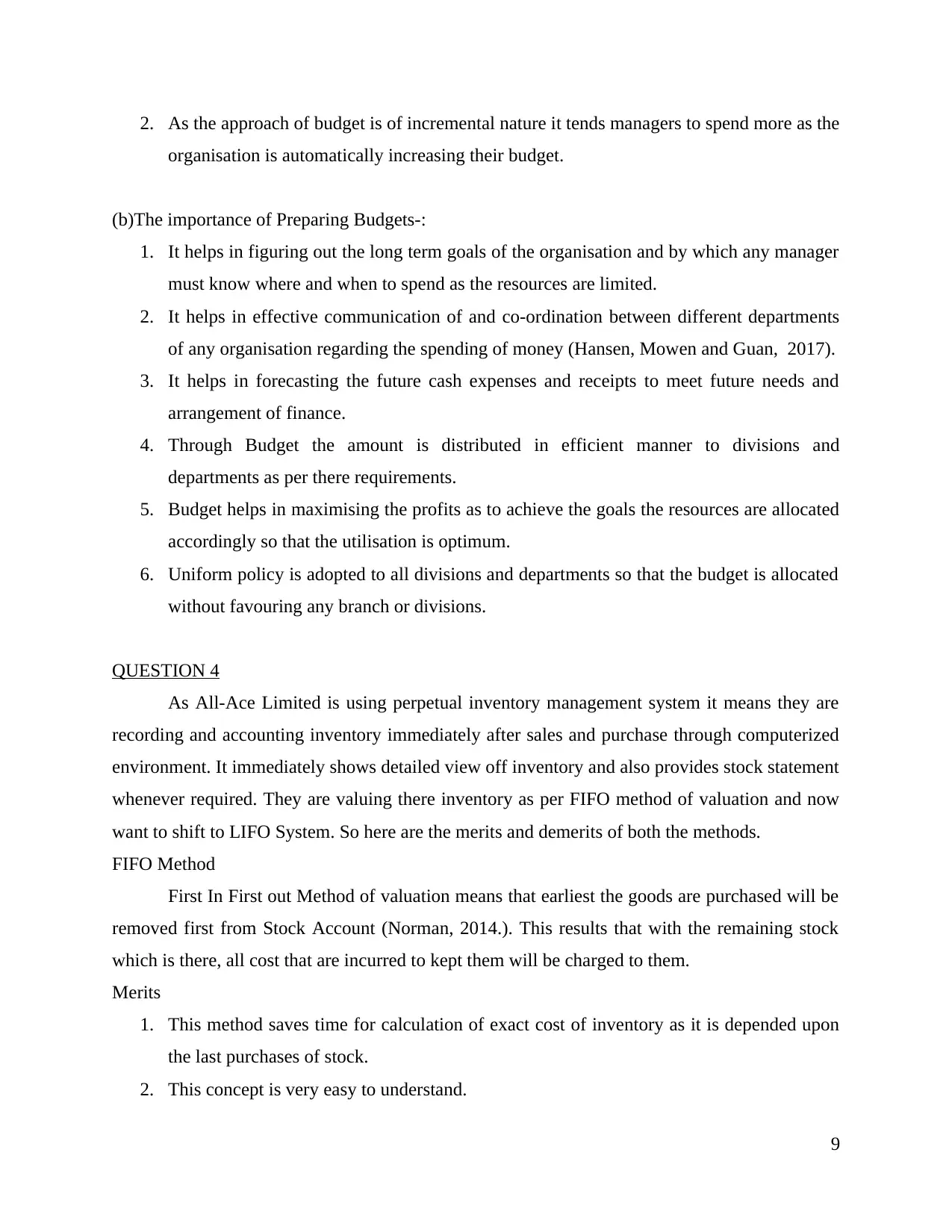
2. As the approach of budget is of incremental nature it tends managers to spend more as the
organisation is automatically increasing their budget.
(b)The importance of Preparing Budgets-:
1. It helps in figuring out the long term goals of the organisation and by which any manager
must know where and when to spend as the resources are limited.
2. It helps in effective communication of and co-ordination between different departments
of any organisation regarding the spending of money (Hansen, Mowen and Guan, 2017).
3. It helps in forecasting the future cash expenses and receipts to meet future needs and
arrangement of finance.
4. Through Budget the amount is distributed in efficient manner to divisions and
departments as per there requirements.
5. Budget helps in maximising the profits as to achieve the goals the resources are allocated
accordingly so that the utilisation is optimum.
6. Uniform policy is adopted to all divisions and departments so that the budget is allocated
without favouring any branch or divisions.
QUESTION 4
As All-Ace Limited is using perpetual inventory management system it means they are
recording and accounting inventory immediately after sales and purchase through computerized
environment. It immediately shows detailed view off inventory and also provides stock statement
whenever required. They are valuing there inventory as per FIFO method of valuation and now
want to shift to LIFO System. So here are the merits and demerits of both the methods.
FIFO Method
First In First out Method of valuation means that earliest the goods are purchased will be
removed first from Stock Account (Norman, 2014.). This results that with the remaining stock
which is there, all cost that are incurred to kept them will be charged to them.
Merits
1. This method saves time for calculation of exact cost of inventory as it is depended upon
the last purchases of stock.
2. This concept is very easy to understand.
9
organisation is automatically increasing their budget.
(b)The importance of Preparing Budgets-:
1. It helps in figuring out the long term goals of the organisation and by which any manager
must know where and when to spend as the resources are limited.
2. It helps in effective communication of and co-ordination between different departments
of any organisation regarding the spending of money (Hansen, Mowen and Guan, 2017).
3. It helps in forecasting the future cash expenses and receipts to meet future needs and
arrangement of finance.
4. Through Budget the amount is distributed in efficient manner to divisions and
departments as per there requirements.
5. Budget helps in maximising the profits as to achieve the goals the resources are allocated
accordingly so that the utilisation is optimum.
6. Uniform policy is adopted to all divisions and departments so that the budget is allocated
without favouring any branch or divisions.
QUESTION 4
As All-Ace Limited is using perpetual inventory management system it means they are
recording and accounting inventory immediately after sales and purchase through computerized
environment. It immediately shows detailed view off inventory and also provides stock statement
whenever required. They are valuing there inventory as per FIFO method of valuation and now
want to shift to LIFO System. So here are the merits and demerits of both the methods.
FIFO Method
First In First out Method of valuation means that earliest the goods are purchased will be
removed first from Stock Account (Norman, 2014.). This results that with the remaining stock
which is there, all cost that are incurred to kept them will be charged to them.
Merits
1. This method saves time for calculation of exact cost of inventory as it is depended upon
the last purchases of stock.
2. This concept is very easy to understand.
9
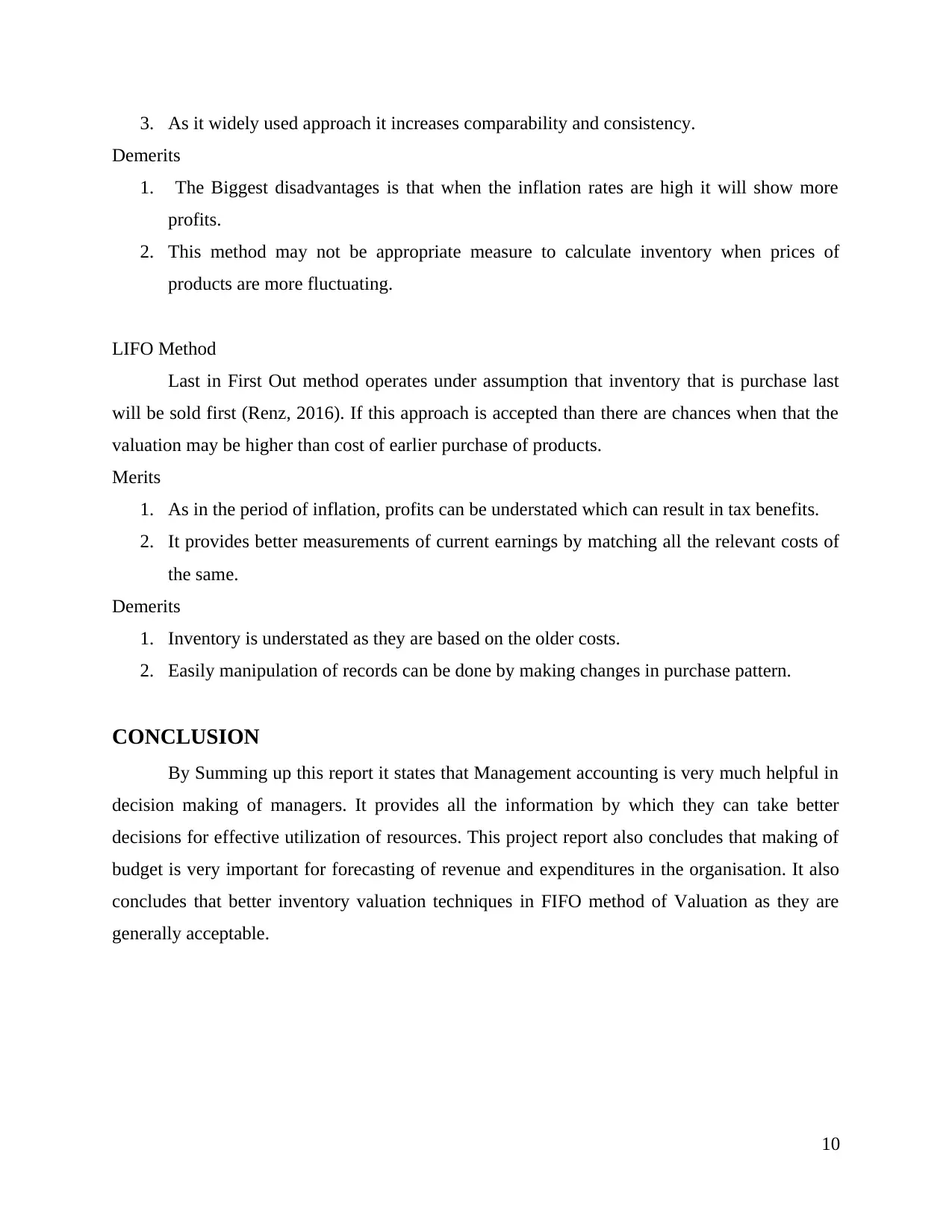
3. As it widely used approach it increases comparability and consistency.
Demerits
1. The Biggest disadvantages is that when the inflation rates are high it will show more
profits.
2. This method may not be appropriate measure to calculate inventory when prices of
products are more fluctuating.
LIFO Method
Last in First Out method operates under assumption that inventory that is purchase last
will be sold first (Renz, 2016). If this approach is accepted than there are chances when that the
valuation may be higher than cost of earlier purchase of products.
Merits
1. As in the period of inflation, profits can be understated which can result in tax benefits.
2. It provides better measurements of current earnings by matching all the relevant costs of
the same.
Demerits
1. Inventory is understated as they are based on the older costs.
2. Easily manipulation of records can be done by making changes in purchase pattern.
CONCLUSION
By Summing up this report it states that Management accounting is very much helpful in
decision making of managers. It provides all the information by which they can take better
decisions for effective utilization of resources. This project report also concludes that making of
budget is very important for forecasting of revenue and expenditures in the organisation. It also
concludes that better inventory valuation techniques in FIFO method of Valuation as they are
generally acceptable.
10
Demerits
1. The Biggest disadvantages is that when the inflation rates are high it will show more
profits.
2. This method may not be appropriate measure to calculate inventory when prices of
products are more fluctuating.
LIFO Method
Last in First Out method operates under assumption that inventory that is purchase last
will be sold first (Renz, 2016). If this approach is accepted than there are chances when that the
valuation may be higher than cost of earlier purchase of products.
Merits
1. As in the period of inflation, profits can be understated which can result in tax benefits.
2. It provides better measurements of current earnings by matching all the relevant costs of
the same.
Demerits
1. Inventory is understated as they are based on the older costs.
2. Easily manipulation of records can be done by making changes in purchase pattern.
CONCLUSION
By Summing up this report it states that Management accounting is very much helpful in
decision making of managers. It provides all the information by which they can take better
decisions for effective utilization of resources. This project report also concludes that making of
budget is very important for forecasting of revenue and expenditures in the organisation. It also
concludes that better inventory valuation techniques in FIFO method of Valuation as they are
generally acceptable.
10
⊘ This is a preview!⊘
Do you want full access?
Subscribe today to unlock all pages.

Trusted by 1+ million students worldwide
1 out of 13
Related Documents
Your All-in-One AI-Powered Toolkit for Academic Success.
+13062052269
info@desklib.com
Available 24*7 on WhatsApp / Email
![[object Object]](/_next/static/media/star-bottom.7253800d.svg)
Unlock your academic potential
Copyright © 2020–2025 A2Z Services. All Rights Reserved. Developed and managed by ZUCOL.




